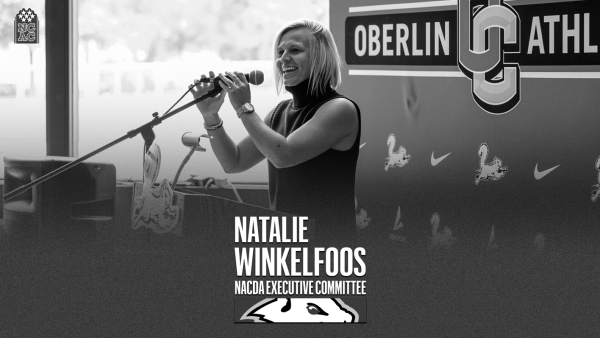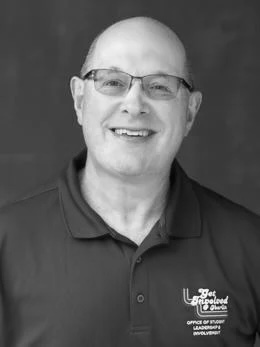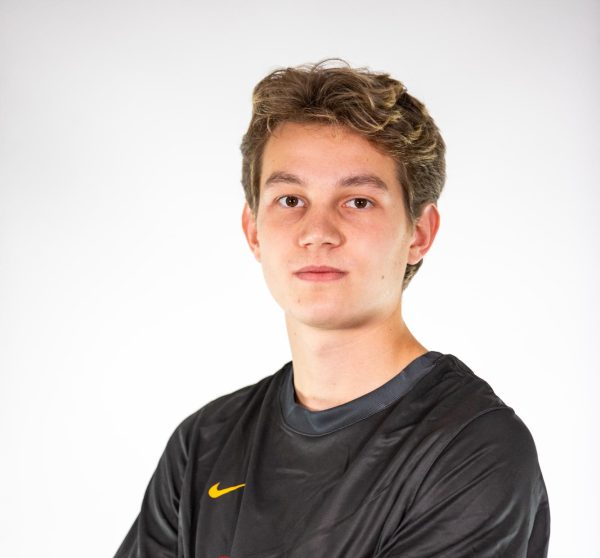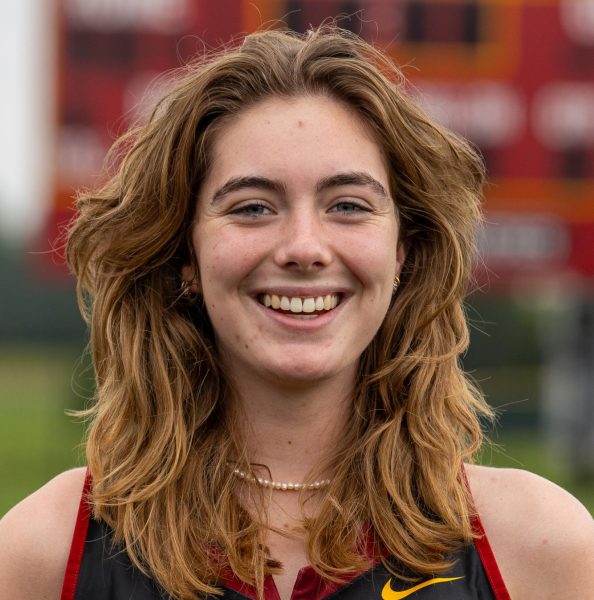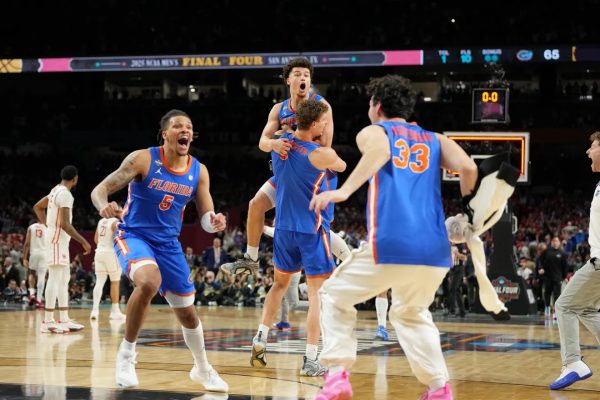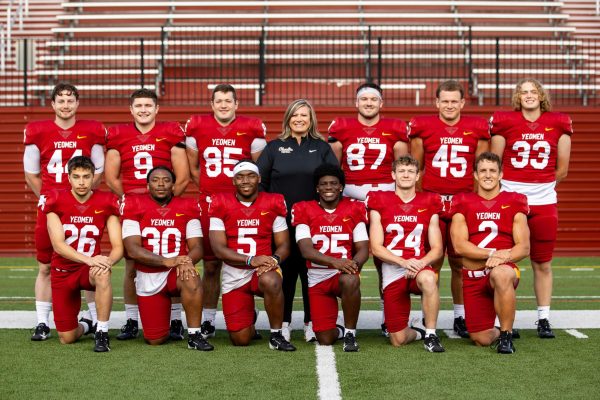Belle Ursa, OC ’17, Founder of Amplio Fitness
Belle Ursa, OC ‘17, and her co-founder John Hall.
Belle Ursa, OC ’17, can be found in Rocky River, Ohio, just a 30-minute drive from Oberlin’s campus. The former Psychology major went on to become an American Council of Exercise-certified coach and founded Amplio Fitness, a fitness and wellness center that provides a safe exercise space for people of marginalized communities. While the center offers a variety of fitness programs, one of its unique features is an exercise program that seeks to affirm the gender identities of transgender and nonbinary individuals. The center recently celebrated its one-year anniversary.
This interview has been edited for length and clarity.
What led you to founding Amplio Fitness?
I went to Oberlin for my B.A. in Psychology, and then I started working at a nonprofit afterwards. I really enjoyed the community and the intention behind social services. However, I felt like I wasn’t doing exactly what I wanted to do. I felt happy, but [finding a] passion is something that really provides you with a sense of satisfaction and completion after a long day of work — it didn’t really provide me that. So I was going to that job, it was nice, and I went through my own personal journey of health and some complications. I went through the ringer, and that led me to playing a more active part in my wellness.
I started with nutrition. I started by Googling facts and diets and things like that, and generally what I needed to do in order to be healthy and be safe. I was having some success, and I really enjoyed that. It brought me happiness in my daily life because I felt more constant and in control. I felt less self-conscious.
Then I thought, “Okay, let’s turn it up a notch and start going to a gym.” I went to a commercial gym, like Planet Fitness, and I had some pretty terrible experiences. With a membership you can get a [session with a] trainer once or twice a week. And most of my trainers were cisgender, heterosexual, white men. Not only did it feel like they were giving me a very generic, cookie-cutter program, but I didn’t feel like they were listening to me or understanding what my goals were. I wasn’t trying to bench 200 pounds; I was trying to improve my daily living at some point. You know, walk a little bit better. Go upstairs without feeling exhausted.
I wasn’t comfortable advocating for myself in that position. It also involved a lot of my gender identity, and I never felt comfortable saying, “Hey, this exercise isn’t for me,” or “This makes me feel uncomfortable,” or “My body doesn’t do that.” Because I felt so unsafe and uncomfortable, I dropped out of the program pretty quickly because I realized, “Why am I going if it doesn’t do it for me or if it doesn’t relate to me?”
I kind of shopped around, and I tried to find another commercial gym that was affordable but not super terrible. I really didn’t find one. So I did more research, and that led me to finding out about getting certified and how to use my B.A. in Psychology as a precursor for my health coaching degree with the American Council of Exercise.
One thing led to another. I had this idea to create a fitness and wellness space where folks like me — other minorities who didn’t feel safe at a commercial gym — could come and learn about fitness and wellness and what that means to them. Our intention at Amplio is to deconstruct what society has deemed unhealthy, and really provide a safe space that has education and opportunity. We provide resources and services where LGBTQ folks, people of color, low-income people, plus-size people, and women can come to ask questions and try different activities and services to figure out what [fitness and wellness] means to them — and to find that joy of taking care of themselves in a non-judgmental, non-discriminatory, safe space where they feel like they can come as they are. The whole point of self-care and wellness is to feel good about yourself and to be good to yourself, and you can’t do that if you are being pushed into a box or assuming that you can only do certain things because of your body size or shape or gender.
How do you approach the relationship between fitness and mental wellness with clients?
We see prime examples on reality TV — shows like The Biggest Loser, for example, and [programs like] CrossFit. A lot of experiences our clients are sharing is that the fitness industry and trainers always have this mindset of, “Go, go, go! Push yourself until you’re in pain, push yourself until you’re throwing up, push yourself until you’re dead — that’s when you know that you’ve done a good day of work.” As a result, people develop this perfectionist, obsessive, highly fragile understanding of what wellness is.
We’ve taken the concepts of fitness and wellness and morphed them so much, and people come into our studio with that understanding. And so our first step is to challenge those ideas people always come into it with — “I need to be this, I need to live this way,” or “I don’t think I can do XYZ because so many people have told me I can’t, because I’m bigger or I’m a woman,” or whatever the case is. And so our first step is to deconstruct that and re-instill control and confidence, even a sense of love, back into the person and into new activities. Sometimes these things are hard, but they can also — and they should also — bring you some form of joy. You should be looking forward to it, not hating it.
I think we address the psychological aspect, because not only are we going to be constructing society’s understanding of what fitness is, but we are providing a space where people can engage with these things. Oftentimes it comes with fear and anxiety and shame and guilt. So we do a lot of work to unpack that and find ways they can face those fears in a setting that is conducive to healthy engagement and exposure, rather than traumatic, forceful interactions with fitness and wellness. We have free consultations, and we do a couple of fitness assessments to see where their balance, flexibility, stability is, because we don’t want to build a program without knowing what safety measures need to be in place first. We need to develop their balance before they start weightlifting, for example, so they don’t fall over or pull something.
That’s honestly where we see a lot of these internalized feelings. We have people of all different sizes, ages and genders come in and say, “I can’t stand on one leg because I’m so big. People have told me I can’t do that my entire life.” And we say, “I hear what you’re saying. Would you be comfortable trying it out, and we’ll have a chair or something to catch your balance in case you fall?” We show them very small, very attainable goals that we know they can do to start to challenge those ideas. When they do that without any issue, we’re like, “Boom, look at that.” They get this wave of confidence and say, “What the hell?” I see that surge of excitement, and we try to build off of that.
How did your time at Oberlin influence your journey to founding Amplio Fitness?
If you asked me while I was at Oberlin what I wanted to do in life, this is definitely not anything I would have ever said. Before, I wasn’t a fitness kind of person, because I always thought it was one way and I didn’t think it was for me. But I think that’s what the beauty of Oberlin was — it exposed me to so much education and learning about social justice issues. I was able to develop my own vocabulary around these things, which helped me learn to push the boundaries and deconstruct and rework these societal concepts that I had fallen into beforehand. But then at Oberlin and post-Oberlin, I was able to look at certain things, like going to a commercial gym, and realize what my experience was, why it was not so great, and what could be better. That language and that perspective that Oberlin helped me achieve was the bud for Amplio. With that, I was able to build and grow and expand.



